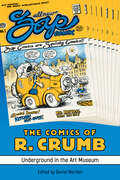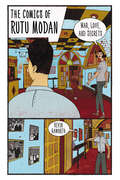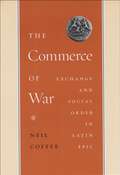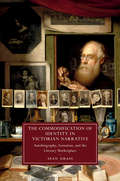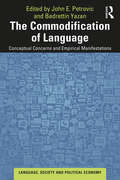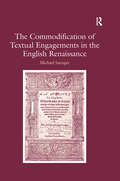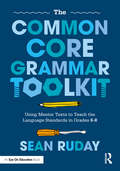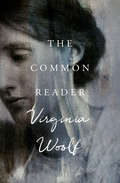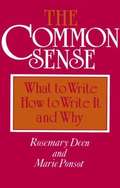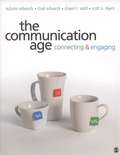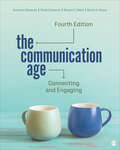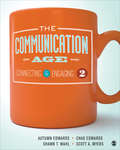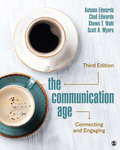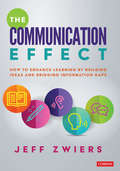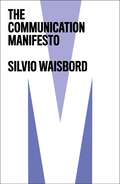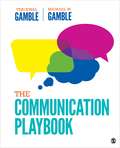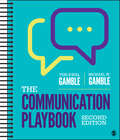- Table View
- List View
The Comics of Julie Doucet and Gabrielle Bell: A Place inside Yourself (Critical Approaches to Comics Artists Series)
by Tahneer Oksman and Seamus O’MalleyWinner of the 2020 Comics Studies Society Edited Book PrizeContributions by Kylie Cardell, Aaron Cometbus, Margaret Galvan, Sarah Hildebrand, Frederik Byrn Køhlert, Tahneer Oksman, Seamus O’Malley, Annie Mok, Dan Nadel, Natalie Pendergast, Sarah Richardson, Jessica Stark, and James Yeh In a self-reflexive way, Julie Doucet’s and Gabrielle Bell’s comics, though often autobiographical, defy easy categorization. In this volume, editors Tahneer Oksman and Seamus O’Malley regard Doucet’s and Bell’s art as actively feminist, not only because they offer women’s perspectives, but because they do so by provocatively bringing up the complicated, multivalent frameworks of such engagements. While each artist has a unique perspective, style, and worldview, the essays in this book investigate their shared investments in formal innovation and experimentation, and in playing with questions of the autobiographical, the fantastic, and the spaces in between. Doucet is a Canadian underground cartoonist, known for her autobiographical works such as Dirty Plotte and My New York Diary. Meanwhile, Bell is a British American cartoonist best known for her intensely introspective semiautobiographical comics and graphic memoirs, such as the Lucky series and Cecil and Jordan in New York. By pairing Doucet alongside Bell, the book recognizes the significance of female networks, and the social and cultural connections, associations, and conditions that shape every work of art. In addition to original essays, this volume republishes interviews with the artists. By reading Doucet’s and Bell’s comics together in this volume housed in a series devoted to single-creator studies, the book shows how, despite the importance of finding “a place inside yourself” to create, this space seems always for better or worse a shared space culled from and subject to surrounding lives, experiences, and subjectivities.
The Comics of R. Crumb: Underground in the Art Museum (Critical Approaches to Comics Artists Series)
by Daniel WordenContributions by José Alaniz, Ian Blechschmidt, Paul Fisher Davies, Zanne Domoney-Lyttle, David Huxley, Lynn Marie Kutch, Julian Lawrence, Liliana Milkova, Stiliana Milkova, Kim A. Munson, Jason S. Polley, Paul Sheehan, Clarence Burton Sheffield Jr., and Daniel Worden From his work on underground comix like Zap and Weirdo, to his cultural prominence, R. Crumb is one of the most renowned comics artists in the medium’s history. His work, beginning in the 1960s, ranges provocatively and controversially over major moments, tensions, and ideas in the late twentieth and early twenty-first centuries, from the counterculture and the emergence of the modern environmentalist movement, to racial politics and sexual liberation. While Crumb’s early work refined the parodic, over-the-top, and sexually explicit styles we associate with underground comix, he also pioneered the comics memoir, through his own autobiographical and confessional comics, as well as in his collaborations. More recently, Crumb has turned to long-form, book-length works, such as his acclaimed Book of Genesis and Kafka. Over the long arc of his career, Crumb has shaped the conventions of underground and alternative comics, autobiographical comics, and the “graphic novel.” And, through his involvement in music, animation, and documentary film projects, Crumb is a widely recognized persona, an artist who has defined the vocation of the cartoonist in a widely influential way. The Comics of R. Crumb: Underground in the Art Museum is a groundbreaking collection on the work of a pioneer of underground comix and a fixture of comics culture. Ranging from art history and literary studies, to environmental studies and religious history, the essays included in this volume cast Crumb's work as formally sophisticated and complex in its representations of gender, sexuality, race, politics, and history, while also charting Crumb’s role in underground comix and the ways in which his work has circulated in the art museum.
The Comics of Rutu Modan: War, Love, and Secrets (Great Comics Artists Series)
by Kevin HaworthBest known for her Eisner Award–winning graphic novels, Exit Wounds and The Property, Rutu Modan’s richly colored compositions invite readers into complex Israeli society, opening up a world too often defined only by news headlines. Her strong female protagonists stick out in a comics scene still too dominated by men, as she combines a mystery novelist’s plotting with a memoirist’s insights into psychology and trauma. The Comics of Rutu Modan: War, Love, and Secrets conducts a close reading of her work and examines her role in creating a comics arts scene in Israel. Drawing upon archival research, Kevin Haworth traces the history of Israeli comics from its beginning as 1930s cheap children’s stories, through the counterculture movement of the 1970s, to the burst of creativity that began in the 1990s and continues full force today. Based on new interviews with Modan (b. 1966) and other comics artists, Haworth indicates the key role of Actus Tragicus, the collective that changed Israeli comics forever and launched her career. Haworth shows how Modan’s work grew from experimental minicomics to critically acclaimed graphic novels, delving into the creative process behind Exit Wounds and The Property. He analyzes how the recurring themes of family secrets and absence weave through her stories and how she adapts the famous clear line illustration style to her morally complex tales. Though still relatively young, Modan has produced a remarkably varied oeuvre. Identifying influences from the United States and Europe, Haworth illustrates how Modan’s work is global in its appeal, even as it forms a core of the thriving Israeli cultural scene.
The Commerce of War: Exchange and Social Order in Latin Epic
by Neil CoffeeLatin epics such as Virgil’s Aeneid, Lucan’s Civil War, and Statius’s Thebaid addressed Roman aristocrats whose dealings in gifts, favors, and payments defined their conceptions of social order. In The Commerce of War, Neil Coffee argues that these exchanges play a central yet overlooked role in epic depictions of Roman society. Tracing the collapse of an aristocratic worldview across all three poems, Coffee highlights the distinction they draw between reciprocal gift giving among elites and the more problematic behaviors of buying and selling. In the Aeneid, customary gift and favor exchanges are undermined by characters who view human interaction as short-term and commodity-driven. The Civil War takes the next logical step, illuminating how Romans cope once commercial greed has supplanted traditional values. Concluding with the Thebaid, which focuses on the problems of excessive consumption rather than exchange, Coffee closes his powerful case that these poems constitute far-reaching critiques of Roman society during its transition from republic to empire.
The Commodification of Identity in Victorian Narrative: Autobiography, Sensation, and the Literary Marketplace (Cambridge Studies in Nineteenth-Century Literature and Culture #121)
by Sean GrassIn the first half of the nineteenth century autobiography became, for the first time, an explicitly commercial genre. Drawing together quantitative data on the Victorian book markets, insights from the business ledgers of Victorian publishers and close readings of mid-century novels, Sean Grass demonstrates the close links between these genres and broader Victorian textual and material cultures. This book offers fresh perspectives on major works by Charles Dickens, George Eliot, Mary Elizabeth Braddon, Wilkie Collins and Charles Reade, while also featuring archival research that reveals the volume, diversity, and marketability of Victorian autobiographical texts for the first time. Grass presents life-writing not as a stand-alone genre, but as an integral part of a broader movement of literary, cultural, legal and economic practices through which the Victorians transformed identity into a textual object of capitalist exchange.
The Commodification of Language: Conceptual Concerns and Empirical Manifestations (Language, Society and Political Economy)
by John E. PetrovicThis volume seeks to add to our understanding of how language is constructed in late capitalist societies. Exploring the conceptual and theoretical underpinnings of the so-called "commodification of language" and its relationship to the notion of linguistic capital, the authors examine recent research that offers implications for language policy and planning. Bringing together an international group of scholars, this collection includes chapters that address whether or not language can rightly be referred to as a commodity and, if so, under what circumstances. The different theoretical foundations of understanding language as a resource with exchange value – whether as commodity or capital – have practical implications for policy writ large. The implications of the "commodification of language" in more empirical terms are explored, both in terms of how it affects language as well as language policy at more micro levels. This includes more specific policy arenas such as language in education policy or family language policies as well as the implications for individual identity construction and linguistic communities. With a conclusion written by leading scholar David Block, this is key reading for researchers and advanced students of critical sociolinguistics, language and economy, language and politics, language policy and linguistic anthropology within linguistics, applied linguistics, and language teacher education.
The Commodification of Textual Engagements in the English Renaissance
by Michael SaengerAn investigation into the ways in which early modern books were advertised, this study argues that those means of advertisement both record and help to shape social interactions between people and books. These interactions are not only fascinating in themselves, but also demonstrably linked to larger social phenomena, such as human commodification, the development of English nationalism, the increasingly unruly proliferation of literacy, and changing conceptions of literature. Within the context of recent developments of new textualism and new economic criticism, Saenger's approach makes use of formalist strategies of genre recognition as well as new historicist connections between social history and art. In this study Saenger illustrates his general account of the formal properties of front matter-titles and subtitles, prefatory epistles, and commendatory verses-with engaging readings of specific examples, including Feltham's Resolves, A Myrrovre for Magistrates, and Sidney's Arcadia. He explores the several ways in which paratextual authors sought to involve the reader in various active roles vis à vis the main text, whether those books were prose fiction or translated continental sermons. Some particular attention is devoted to printed drama, both because dramatic texts present printers with a unique set of challenges and because those texts have often been misread in recent criticism. This book offers a much-needed analysis of profound transformations-not only to the book trade as an industry, but also to the very concepts of reading and authorship-in an age which saw the relatively brief coincidence of ancient marketing strategies and systems and the burgeoning market of the mechanically reproduced text.
The Common Core Grammar Toolkit: Using Mentor Texts to Teach the Language Standards in Grades 6-8
by Sean RudayThe Common Core’s language standards can seem overwhelming—students need to learn specific, complex grammar rules at each grade level. The Common Core Grammar Toolkit to the rescue! This comprehensive guide makes grammar instruction fun and meaningful. You will learn how to… • Teach the Common Core’s language standards for grades 6–8 by presenting each grammar rule as a useful writing tool.• Use mentor texts—excerpts from great literature—to help students understand grammar in action.• Promote metacognition along the way, so that students become responsible for their own learning. The book thoroughly covers how to teach the Common Core’s language standards for grades 6-8, on topics such as understanding intensive pronouns, using commas to set off nonrestrictive clauses, maintaining consistency in style and tone, forming verbs in different moods, and much, much more. You’ll learn how to present each of these grammar rules to your students as tools that will help them improve their writing. You’ll also find classroom snapshots that show the tools in action, and handy, reproducible charts that you can use with your own students. Bonus! The book includes a free annotated bibliography, which is offered as a Supplemental Download on our website. The bibliography lists high-quality young adult literature and gives examples of key grammatical concepts found in each work, so you can use additional mentor texts with your students.
The Common Growl: Toward a Poetics of Precarious Community (Commonalities)
by Thomas ClaviezNo longer able to read community in terms colored by a romantic nostalgia for homogeneity, closeness and sameness, or the myth of rational choice, we nevertheless face an imperative to think the common. The prominent scholars assembled here come together to articulate community while thinking seriously about the tropes, myths, narratives, metaphors, conceits, and shared cultural texts on which any such articulation depends. The result is a major contribution to literary theory, postcolonialism, philosophy, political theory, and sociology.
The Common Reader: First Series, Annotated Edition (The Common Reader #1)
by Virginia WoolfA collection of essays from the acclaimed author of Mrs. Dalloway on such subjects as Jane Austen, Geoffrey Chaucer, and her own literary philosophy. A good essay must have this permanent quality about it; it must draw its curtain round us, but it must be a curtain that shuts us in not out. Not written for scholars or critics, these essays are a collection of Virginia Woolf&’s everyday thoughts about literature and the world—and the art of reading for pleasure. That many of them previously appeared in such publications as the Nation, Vogue, and the Yale Review points to their widespread appeal. Still, her brilliant powers of observation and insatiable curiosity shine through . . . &“After all, Mrs. Woolf is no common reader, try as she may to be one. Her powers of coordination and logical inference are altogether too strong and capable. No common reader would kick the over-praised Robinson Crusoe overboard to float in seas of adolescent adoration for Moll Flanders, as she does. It would take an uncommon common reader to discourse as pithily on Elizabethan drama or the furiously literary Duchess of Newcastle. No idle peruser of the printed page would meditate so beautifully on Greek letters. And when we come to those essays, &‘Modern Fiction&’ and &‘How It Strikes a Contemporary,&’ a note that is altogether professional and the result of intensive study and theorizing is to be discerned.&” —The New York Times &“Woolf&’s provocative collection of essays, reviews and flights of literary imagination assesses both the famous and the obscure.&” —The Times (London)
The Common Sense: What to Write, How to Write It, and Why
by Marie Ponsot Rosemary DeenThis is a brief book teaching the elements of writing inductively, by organized experience; and concentrating the practice of writing on the expository essay, the essay which supports what it asserts. You can use the book for four kinds of expository writing courses. The most beautiful course, which underlies the others, is "Elements of the Essay." It suits inexperienced writers of all ages; or writers who want to practice all the elements of writing in a developing way; or mixed groups of writers. The second course, "Two-Part Essay Shapes", teaches the essay by beginning with classic forms. Both the third and fourth courses include analysis of outside texts.
The Communication Age: Connecting and Engaging
by Autumn Edwards Chad Edwards Shawn T. Wahl Scott A. MyersNo matter who you are or how you communicate―from baby boomers to millenials, born digital or getting there―we are all members of a society who connect through the internet, not just to it. From face-to-face to facebook, this book by Autumn Edwards, Chad Edwards, Shawn T. Wahl, and Scott A. Myers invites you to join the conversation about today's issues and have your voice heard.
The Communication Age: Connecting and Engaging
by Autumn Edwards Shawn T. Wahl Scott A. Myers Chad C. EdwardsWhen should you send a text message, and when is it more appropriate to talk face-to-face? What is the best way to prepare for a job interview that will be conducted over video? How should you modify your speech if it will be recorded and posted online? The Communication Age: Connecting and Engaging introduces students to the foundational concepts and essential skills of effective communication, with a strong emphasis on the impact of technology in our increasingly interconnected world. This new Fourth Edition helps students become involved in our diverse global community and learn how to apply key principles of effective communication—whether incorporating media, technology, or traditional face-to-face speech communication—to foster civic engagement for a better future. With comprehensive coverage of the essentials of interpersonal, small group, and public communication, this text is ideal for use in hybrid introduction to communication courses.
The Communication Age: Connecting and Engaging
by Autumn Edwards Shawn T. Wahl Scott A. Myers Chad C. EdwardsWhen should you send a text message, and when is it more appropriate to talk face-to-face? What is the best way to prepare for a job interview that will be conducted over video? How should you modify your speech if it will be recorded and posted online? The Communication Age: Connecting and Engaging introduces students to the foundational concepts and essential skills of effective communication, with a strong emphasis on the impact of technology in our increasingly interconnected world. This new Fourth Edition helps students become involved in our diverse global community and learn how to apply key principles of effective communication—whether incorporating media, technology, or traditional face-to-face speech communication—to foster civic engagement for a better future. With comprehensive coverage of the essentials of interpersonal, small group, and public communication, this text is ideal for use in hybrid introduction to communication courses.
The Communication Age: Connecting and Engaging
by Dr Shawn T. Wahl Dr Chad C. Edwards Dr Scott A. Myers Dr Autumn EdwardsWe are in “the communication age.” No matter who you are or how you communicate, we are all members of a society who connect through the internet, not just to it. From face-to-face interactions to all forms of social media, The Communication Age, Second Edition invites you to join the conversation about today’s issues and make your voice heard. This contemporary and engaging text introduces students to the essentials of interpersonal, small group, and public communication while incorporating technology, media, and speech communication to foster civic engagement for a better future.
The Communication Age: Connecting and Engaging
by Dr Shawn T. Wahl Dr Chad C. Edwards Dr Scott A. Myers Dr Autumn EdwardsWhen should you send a text message, and when is it more appropriate to talk face-to-face? What is the best way to prepare for a job interview that will be conducted over video? How should you modify your speech if it will be recorded and posted online? The Communication Age: Connecting and Engaging by Autumn Edwards, Chad Edwards, Shawn T. Wahl, and Scott A. Myers introduces students to the foundational concepts and essential skills of effective communication, with a strong emphasis on the impact of technology in our increasingly interconnected world. This new Third Edition helps students become involved in our diverse global community and learn how to apply key principles of effective communication—whether incorporating media, technology, or traditional face-to-face speech communication—to foster civic engagement for a better future. With comprehensive coverage of the essentials of interpersonal, small group, and public communication, this text is ideal for use in hybrid introduction to communication courses.
The Communication Age: Connecting and Engaging
by Dr Shawn T. Wahl Dr Chad C. Edwards Dr Scott A. Myers Dr Autumn EdwardsWhen should you send a text message, and when is it more appropriate to talk face-to-face? What is the best way to prepare for a job interview that will be conducted over video? How should you modify your speech if it will be recorded and posted online? The Communication Age: Connecting and Engaging by Autumn Edwards, Chad Edwards, Shawn T. Wahl, and Scott A. Myers introduces students to the foundational concepts and essential skills of effective communication, with a strong emphasis on the impact of technology in our increasingly interconnected world. This new Third Edition helps students become involved in our diverse global community and learn how to apply key principles of effective communication—whether incorporating media, technology, or traditional face-to-face speech communication—to foster civic engagement for a better future. With comprehensive coverage of the essentials of interpersonal, small group, and public communication, this text is ideal for use in hybrid introduction to communication courses.
The Communication Age: Connecting and Engaging
by Dr Shawn T. Wahl Dr Chad C. Edwards Dr Autumn P. Edwards Dr Scott A. MyersWe are in "the communication age." No matter who you are or how you communicate, we are all members of a society who connect through the internet, not just to it. From face-to-face interactions to all forms of social media, The Communication Age, Second Edition invites you to join the conversation about today's issues and make your voice heard. This contemporary and engaging text introduces students to the essentials of interpersonal, small group, and public communication while incorporating technology, media, and speech communication to foster civic engagement for a better future.
The Communication Effect: How to Enhance Learning by Building Ideas and Bridging Information Gaps
by Jeff ZwiersThe &“communication effect&” is what happens when we saturate our classrooms with authentic communication, which occurs when students use language to build up ideas and do meaningful things. For starters, authentic communication deepens and increases language development, learning of content concepts and skills, rigor and engagement, empathy and understanding of others&’ perspectives, agency and ownership of core ideas across disciplines, and social and emotional skills for building strong relationships. And these are just the starters. With The Communication Effect, Dr. Jeff Zwiers challenges teachers in Grades 3 and up to focus less on breadth and more on depth by grounding instruction and assessment in authentic (rather than pseudo-) communication. This book provides: Ideas for cultivating classroom cultures in which authentic communication thrives Clear descriptions and examples of the three features of authentic communication: 1. building up key ideas (claims and concepts); 2. clarifying terms and supporting ideas; and 3. creating and filling information gaps Over 175 suggestions for using the three features of authentic communication to enhance twenty commonly used instructional activities across disciplines Additional examples of not-so-commonly-used activities that embody the three features Suggestions for improving four different types of teacher creativity needed to design effective lessons, activities, and assessments that maximize authentic communication Our students deserve to get the most out of each minute of each lesson. Authentic communication can help. As you read The Communication Effect and apply its ideas, you will see how much better equipped and inspired your students are to grow into the amazing and gifted people that they were meant to become.
The Communication Effect: How to Enhance Learning by Building Ideas and Bridging Information Gaps
by Jeff ZwiersThe &“communication effect&” is what happens when we saturate our classrooms with authentic communication, which occurs when students use language to build up ideas and do meaningful things. For starters, authentic communication deepens and increases language development, learning of content concepts and skills, rigor and engagement, empathy and understanding of others&’ perspectives, agency and ownership of core ideas across disciplines, and social and emotional skills for building strong relationships. And these are just the starters. With The Communication Effect, Dr. Jeff Zwiers challenges teachers in Grades 3 and up to focus less on breadth and more on depth by grounding instruction and assessment in authentic (rather than pseudo-) communication. This book provides: Ideas for cultivating classroom cultures in which authentic communication thrives Clear descriptions and examples of the three features of authentic communication: 1. building up key ideas (claims and concepts); 2. clarifying terms and supporting ideas; and 3. creating and filling information gaps Over 175 suggestions for using the three features of authentic communication to enhance twenty commonly used instructional activities across disciplines Additional examples of not-so-commonly-used activities that embody the three features Suggestions for improving four different types of teacher creativity needed to design effective lessons, activities, and assessments that maximize authentic communication Our students deserve to get the most out of each minute of each lesson. Authentic communication can help. As you read The Communication Effect and apply its ideas, you will see how much better equipped and inspired your students are to grow into the amazing and gifted people that they were meant to become.
The Communication Manifesto
by Silvio WaisbordContemporary societies demand clear-minded, evidence-based ideas to address complex social issues. Communication scholarship has a rich trove of knowledge and experiences to help address such problems. In this passionately argued manifesto, Silvio Waisbord examines public scholarship in communication studies and its potential for contributing to the common good. He discusses the various ways scholars seek to serve the public as practitioners, experts, advocates, activists and critics, and underscores their significant contribution which has not, to date, been properly supported or recognized. Only by tackling academic institutional politics, he argues, will it be possible to strengthen public scholarship as central to the mission of communication studies. The Communication Manifesto is a roadmap to action and will inspire communication scholars and students to be public citizens, thereby connecting their work and expertise to the causes of solidarity, humanity and social justice.
The Communication Playbook
by Teri Kwal Gamble Michael W. GambleSkills for becoming clear communicators, confident speakers, and sharp thinkers. Designed for today’s active learners, The Communication Playbook moves students beyond the classroom by helping them develop a strong communication skillset that will benefit them throughout their lives. With a focus on effective communication skills and career success, bestselling authors Teri Kwal Gamble and Michael K. Gamble give students clear explanations of core concepts followed by practical learning activities—encouraging students to think critically about why good communication is important and how the concepts can be applied to today’s classroom, workplace, and community. Perfect for the hybrid communication course with coverage of public speaking, this concise text has been strategically separated into tabbed chapters—making it easier for readers to navigate, digest, revisit, and review the content. As good communication is the foundation of everyday life, The Communication Playbook primes students for success in both their courses and their careers.
The Communication Playbook
by Teri Kwal Gamble Michael W. GambleSkills for becoming clear communicators, confident speakers, and sharp thinkers. Designed for today’s active learners, The Communication Playbook moves students beyond the classroom by helping them develop a strong communication skillset that will benefit them throughout their lives. With a focus on effective communication skills and career success, bestselling authors Teri Kwal Gamble and Michael K. Gamble give students clear explanations of core concepts followed by practical learning activities—encouraging students to think critically about why good communication is important and how the concepts can be applied to today’s classroom, workplace, and community. Perfect for the hybrid communication course with coverage of public speaking, this concise text has been strategically separated into tabbed chapters—making it easier for readers to navigate, digest, revisit, and review the content. As good communication is the foundation of everyday life, The Communication Playbook primes students for success in both their courses and their careers.
The Communication Playbook
by Teri Kwal Gamble Michael W. GambleIdeal for hybrid communication courses, The Communication Playbook is designed to equip students with the tools they need to develop communicative resilience in their personal and public lives, whether face-to-face or virtually. Supported by practical learning activities and exercises, along with discussions of timely topics such as events of extremism, a global pandemic, and the technological and multicultural nature of society, bestselling authors Teri Kwal Gamble and Michael W. Gamble help students navigate the physical and digital realms of communication, enabling them to become clear, confident communicators. The Second Edition includes updated examples, new annotated speeches on up-to-date topics, and greater coverage of how technology and culture influences communication. This title is accompanied by a complete teaching and learning package. Contact your SAGE representative to request a demo. Digital Option / Courseware SAGE Vantage is an intuitive learning platform that integrates quality SAGE textbook content with assignable multimedia activities and auto-graded assessments to drive student engagement and ensure accountability. Unparalleled in its ease of use and built for dynamic teaching and learning, Vantage offers customizable LMS integration and best-in-class support. It’s a learning platform you, and your students, will actually love. Learn more. Assignable Video with Assessment Assignable video (available with SAGE Vantage) is tied to learning objectives and curated exclusively for this text to bring concepts to life. Watch a sample video now. LMS Cartridge: Import this title’s instructor resources into your school’s learning management system (LMS) and save time. Don’t use an LMS? You can still access all of the same online resources for this title via the password-protected Instructor Resource Site. Learn more.

